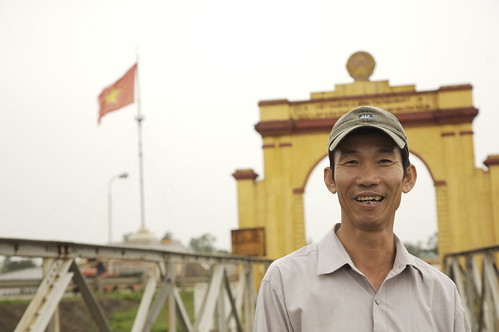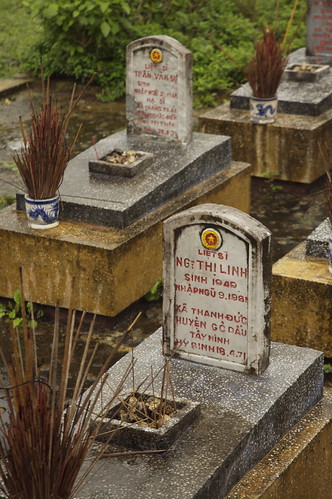We drove along a modern highway towards the DMZ, the road follows one of the many paths of the Ho Chi Minh Trail, which was the major supply route for the North Vietnamese and Viet Cong (VC), during ‘The American War’. Whilst most of the west refers to the war here as ‘The Vietnam war’, the Vietnamese, call it The American War.
We walked, sticking close to the path, through the jungle, past Rubber Plantations and black pepper trees, towards a high strategic point and a former US bunker. On the walls of the bunker, alongside the bullet holes, was the word CALIFORNIA, probably carved by a young conscript, sent to fight a war in a land he knew little of and for what?
Along the way we passed scraps of missiles and other debris, which still littered the land. We saw two guys searching for booty with a metal detector.
‘For more than three decades four armies expended untold energy and resources mining, booby-trapping, rocketing, strafing, mortaring and bombarding wide areas of Vietnam… It’s estimated that as much as 20% of Vietnam remains uncleared, with more than three million mines and 350,000 to 800,000 tonnes of unexploded ordnance (UXO)… Between 1975 and 2000 it resulted in the deaths of 38,849 people and 65,852 injuries nationwide. Around 1200 to 3000 people are injured every year.’*
We were told that many of the people that are injured or killed each year are collecting debris to sell as scrap. Children are often killed whilst playing in their fields attracted by fatal shining objects.
What’s even more sickening is when you think, people still manufacture and use these ‘weapons’!!! Lady Diana was perhaps one of the most famous ‘activists’ against Landmines, and it is argued that:
‘Due to the amount of influence she had, her death in August 1997 sparked the Government of the United Kingdom and other nations to ratify and sign the Ottawa Treaty.’
Introducing the Second Reading of the Landmines Bill 1998 to the British House of Commons, the Foreign Secretary, Robin Cook, paid tribute to Diana's work on landmines:
“ All Honourable Members will be aware from their postbags of the immense contribution made by Diana, Princess of Wales to bringing home to many of our constituents the human costs of landmines. The best way in which to record our appreciation of her work, and the work of NGOs that have campaigned against landmines, is to pass the Bill, and to pave the way towards a global ban on landmines.” —Robin Cook
More
A much more fitting tribute than the Elton John Songs, fountains and celebrity concerts.
Thankfully the UK did sign the treaty, however China, India, Russia and the United States are amongst the 37 countries which haven’t. *
Cambodia also has a major problem with landmines today. At Beng Mealea, a major tourist destination near Siem Reap, I saw a sign saying that this area was cleared of mines by CMAC, started 08/06/2006, completed 12/09/2007, funded by The Federal Republic of Germany. Large areas still remain in danger.
Lets not forget about the ‘collateral damage’ in Iraq, Afghanistan... where UXO from cluster bombs are killing and maiming innocents today, funded by us nice British and US taxpayers. Many of these are Uranium enriched mounting to Nuclear Warfare.
We visited a cemetery for North Vietnamese soldiers. Many of the graves were unmarked, some had what information they could figure out from battered documents, whilst others had full details. We stopped at the Grave of a young female North Vietnamese soldier. She 'volunteered' when she was 12 and died tens years later.
We then headed ontoen Luong bridge on the Ben Hai river, which served as the demarcation line between the Republic of Vietnam (RVN; South Vietnam) and the Democratic Republic of Vietnam (DRV; North Vietnam). On the southern side of the bridge there is a Monument to women and children of Vietnam. The sculpture depicts mother and children looking north over the river from South Vietnam, waiting for their husbands to return, of course many didn't.
The speaker stacks that blasted out propaganda, from each side, were still standing.
We headed to the Vinh Moc Tunnels.
‘In 1966 the USA began a massive aerial and artillery bombardment of North Vietnam. Just north of the DMZ, the villagers of Vinh Moc found themselves living in one of the most heavily bombed and shelled strips of land on the planet. Small family shelters could not withstand this onslaught and villagers either fled or began tunnelling by hand into the red-clay earth.’*
The Vinh Moc Tunnels are an amazing 2.8km network of tunnels, built on the coast, just north of the Ben Hai River. Whole families lived here and 17 babies were born in the underground delivery room.
‘Later, the civilians and VC were joined by North Vietnamese soldiers, whose mission was to keep communications and supply lines to nearby Con Co Island open.’*
It’s impossible to imagine how people could live and grow up here, underground in the dark and damp with little supplies and under aerial bombardment and gunfire from US naval ships.
For more history and background on 'The American War' Read John Pilger's articles on Vietnam
Links and Sources
Support International Campaign to Ban Landmines http://www.icbl.org/
Read Robert Fisk on Cluster Bombs and US terrorism - http://www.robert-fisk.com/american_terrorism.htm
Mines Advisory Group http://www.mag.org/
Cluster Bombs Petition http://www.minesactioncanada.org/home/index.cfm?fuse=Home.Petition
http://en.wikipedia.org/wiki/Land_mine
http://en.wikipedia.org/wiki/Cluster_bomb
http://en.wikipedia.org/wiki/Vietnam_War
Read Articles on Vietnam by John Pilger
http://www.johnpilger.com/page.asp?partid=273
* Lonely Planet, Vietnam (2007) pg 476, 203, 204.




No comments:
Post a Comment